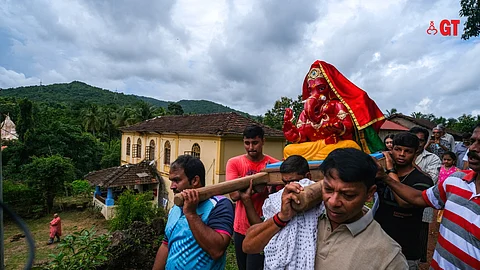

In an era when you find nuclear, or small, families celebrating Ganesh Chaturthi, the Suryarao Sardesai family of Savoi Verem, Goa, consisting of over 40 families, comes together at their ancestral home to celebrate the festival. Not just that, the family is also known to bring home a red coloured idol of Lord Ganesh.
Hands on historian, Sanjeev Sardesai, who is a member of the Sardesai family, explains why the family brings home a red idol of the god.
Sanjeev says, "Our Suryarao Sardesai family, of Savoi-Verem, is one of the most renowned families of the village. It belongs to the warrior-Brahmin community, and are known to bring home a red coloured idol of Lord Ganesh, which symbolises their warrior ancestry."
Way back, during the Bijapuri rule in Goa, the term 'Sardesai' was a title (deski) granted by the Adilshahi Court to the head, or in-charge, of the 'Desais' or 'administrators' of the lands of the Shah, and it was later accepted by the family as their surname.
"That is how we were bestowed with the title of ‘Sardesai’ which later became our surname," adds Sanjeev.
CHATURTHI AT THE SARDESAI HOME
There are over 40 families under the Suryarao Sardesai umbrella, which consists of over a hundred people. The family members who have gone to faraway lands for jobs, or had to part from the house due to family expansion, make it a point to visit the ancestral house to pray and share a festive meal as one big family.
The Sardesais worship Ganesha for one and half day. On Chaturthi day, their festive rituals begin as early as 10.30 am, when the family members ready a palanquin, and then set out to bring the idol of Ganesha.
On their way, they stop at a tree – there, they offer prayers, seek blessings, break a coconut, and then serve jaggery and coconut kernel pieces to the people who are going to bring the idol.
Sanjeev informs that this used to be an age-old practice, and it was believed that the jaggery and coconut kernel pieces would give strength to the people heading out to get the idol.
When they reach the house of the idol maker, they place the idol inside the palanquin, and ensure that the head of the idol is covered with a special cloth. This is done to prevent any bird droppings on the idol while transporting it.
After that, they resume their journey back to their home, a journey which takes them through many narrow lanes and mud roads, before finally reaching the majestic, ancestral Sardesai house.
MORE THAN FAMILY
Sanjeev adds that although the house is filled with family members, you will also find neighbours joining in their arti despite having Ganesh in their own homes. "This is because these neighbours have been joining us for years and are, thus, consider to be a part of the Sardesai family," says Sanjeev.
He also speaks about how this festival gives the family an opportunity to pass down their traditions and values to the next generation.
He shares a simple example. "The elder womenfolk involve the young daughters and new daughters-in-law while preparing the culinary fare, and pass on the culinary secrets to them, be it food without garlic and onion (which is a specialty of the festival), or rolling the puris," says he.
"The elderly would involve the young girls and daughters in all the festive rituals, and teach them to prepare food, especially without garlic and onion," he adds.
The Sardesais are just one of the many families in Goa who come together in large numbers for festive celebrations such as Ganesh Chaturthi.
For Goa's Hindu's, Ganesh Chaturthi is not just about welcoming vignaharatha in their homes, but also about bringing the entire family together as one.
For that reason, you will notice that most of the large families bring only one idol in their ancestral homes.